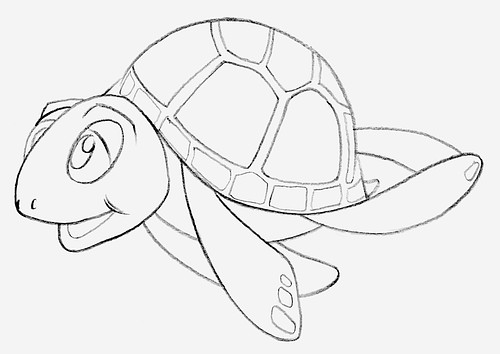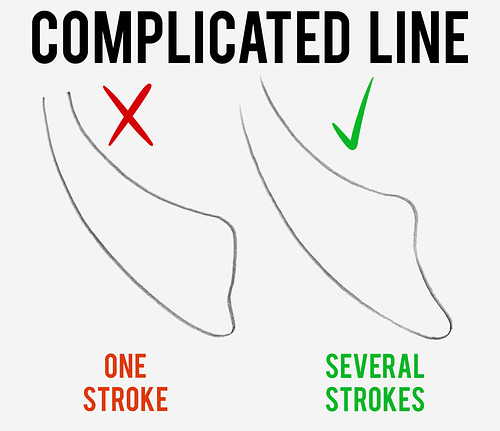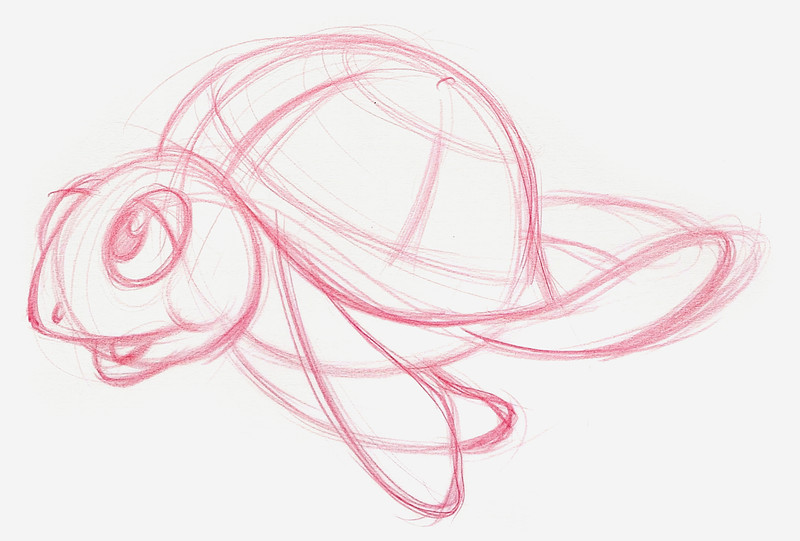If you're having a difficult time executing a tapered stroke, the "Follow Through" and "Ghosting" techniques from the 6 Habits for Good Line Quality lesson should help you.
Hey, let's build some confidence in your line quality! The type of stroke you should practice to get confident looking lines is the tapered stroke. It's a single movement of the hand that creates a line thicker in the middle and tapers to a point on both ends. I'll show you two important ways to use tapered strokes. Tapered strokes are great for loose sketching, but first, I want to show you how you can use tapered strokes to construct complex lines.
Construct Complex Lines
My animation teacher in high school, Nataha Lightfoot, taught me this stroke to clean up my preliminary rough sketches after a gestural loose drawing, I put a sheet over the rough on a light table and traced it with a cleaner line for the final animation. Tapering your strokes helps make sure your line is clean all the way around because you can construct a complex line out of many overlapping, simple strokes.
When you break down a line into parts and layer one stroke after another, it looks like one clean line in the end.
It's hard to pull a complicated stroke with many turns in one shot. It's much easier to split the line into several parts, stop to let your mind catch up, reposition your hand for a more comfortable angle, and then execute the next piece of that line.
Now I have this complex shape that looks like a single clean line. This gives you a really solid contour, which holds the object together and makes it feel solid too.
Loose Sketching
Tapered strokes are not just about cleaning up your outlines. In fact, they're even better for loose sketches. In a loose sketch, you deliberately create a more sloppy, gestural drawing with lines that don't necessarily connect.
The focus of the loose sketch. Is to explore an idea. And you're not letting a perfectionist mentality distract you from that exploration.
And you know that you can always bring it into digital, clean it up, color it, but you don't have to clean it up because a tapered stroke looks good, even if it doesn't connect with the line next to it.
Tapered strokes result in a more gestural line with momentum and energy. Since your hand has to be in motion the whole time, rather than placing the pencil on the paper, pulling the stroke, stopping and lifting the pencil. Think of accelerating your car gradually until you reach full momentum and then letting the car slow down naturally versus going full speed, then slamming on the brakes over and over again. That's not an enjoyable ride.
When you use un-tapered strokes that end abruptly and don't meet properly. You create a choppy contour which is distracting for the viewer because the eye is jumping from one point to the next. The smooth transitions of the tapered line Keep your eye moving, even if they don't connect perfectly. Tapered lines add movement, energy, and confidence to a drawing.
If you look at Disney production sketches, you can see how the animators use tapered strokes. They're very loose and gestural. The drawings are not clean, but they're drawn deliberately with purpose. There's an intentional energy in these drawings, and there is no confusion or hesitation in their strokes. They're not uptight, and that makes these drawings very beautiful. I would even argue that the loose drawings look better than the clean versions when they're individual images because cleaning them up loses some of that energy and charm.
But of course, these were not made to be seen as individual images. These are made for animated films to be seen sequentially to give the illusion of motion. And maybe clean lines are better for that purpose.
Conclusion
Hopefully you see the benefits of mastering the tapered stroke. To start practicing, try drawing simple shapes first, gradually increasing the complexity.
You can even just skate around the page to make random shapes with tapered strokes. And a reminder, because it's so important. Use your shoulder, elbow, wrist, and don't squeeze the pencil too hard. In the next several lessons of my drawing Basics course, I'm going to give you projects, demos, warm ups, and critiques to help you improve your line quality.
In the next project, we're going to practice loose sketching. It's going to be fun!




